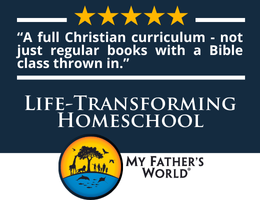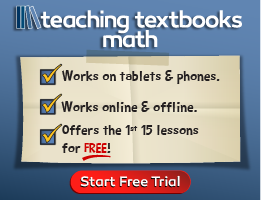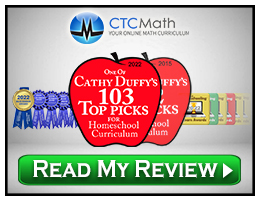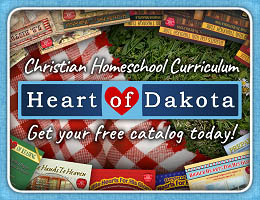Beautiful Feet Books publishes three United States geography studies that can be used across the span from kindergarten through seventh grade. The first study they published focused on books by Holling C. Holling, and I review it separately. Here I review the two other studies, Geography: A Literature Approach for Primary Grades (K-3) and U.S. Geography for Intermediate Grades (4-6). Both are year-long courses with 36 and 37 lessons, respectively.
Each course has a full-color Beautiful Feet guide book that provides detailed lesson plans for the use of information books, literature, mapwork, writing, videos, projects, field trips, and cooking. A lengthy list of books is required for each course. Some will be used throughout the course and should be purchased, but many can be found at your library. Complete courses with all required books and a U.S. map can be purchased from Beautiful Feet Books, or you can purchase individual items. The same U.S. Map is used for both courses. This is an outline map on which students write, draw, and color. Students completing both courses should have a fresh map for each course.
For both courses, students compile a notebook with their drawings, written work (including a glossary of terms), and other coursework. Intermediate students can also create pages with key facts about each state as directed in “Dig Deeper” sections of their lessons. Students can use whatever art media they want, although colored pencils are probably best for the primary grades.
Courses are divided into sections, with many lessons per section, each varying in content. Students should complete one lesson per week. Lessons tell which pages to use in which books, and usually follow up with related map work, coloring, and website visits at the younger level, adding discussion, research, and writing at the intermediate level.
Each lesson includes one or more optional sections titled Dig Deeper, Explore Your World, or Culinary Connections. The Intermediate guide adds Nature Journaling assignments under Explore Your World.
Dig Deeper goes beyond the required resources, usually having students access websites to learn more. For instance, on page 59 of the guide for the primary grades, students are given opportunities to learn about the northern lights or about arguments regarding the definition of a lake. On page 29 of the intermediate guide, students are provided with a website link to “Check out this experiment to see how the grasses and plants in estuaries both filter water and prevent soil loss.” Dig Deeper suggestions sometimes include activities, such as one in the intermediate guide that says, “Draw or paint examples of each type of mountain and label them in the notebook. You may also print out photographs of the different types of mountains to add to your notebook, or use the graphics in the Picture Packet” (p. 30).
Explore Your World often takes students outside the classroom. For example, the guide for primary students suggests visiting an estuary and recording or drawing what they observe, and page 46 suggests visits to either the Crater of Diamonds State Park or Hot Springs National Park in Arkansas or to Gateway Arch National Park in Missouri. Website links are included for either planning visits or virtually exploring parks you are unable to visit. In the intermediate guide, page 11 recommends a visit to a wetland, and page 71 has students use a graph template from the Picture Packet to record the countries of origin for produce in their local grocery store.
Culinary Connections provide one or more links to websites with recipes related to the state(s) being studied.
A Rabbit Trails page (or two) in each section has an annotated list of additional suggested books to read with your children. You might also choose from this list to learn more about a particular state or area, or to find a substitute for one of the required books.
Guides for both courses have a QR code near the front that takes you to a page at Beautiful Feet Books where you can download additional, free resources for the courses. (In case you have trouble with QR codes, here are links to the primary grades page and the intermediate grades page.) Picture Packets have printable images and activity pages needed for the lessons—six pages for the primary grades and 42 pages for the intermediate grades. A free downloadable collection of 18 Bible verses related to God’s creations (different for each course) is optional. These webpages also link to another page with website links for each course. Within the guide, recommended videos sometimes include URLS, but they also provide the video title and website in case links don’t work. The online pages of links include URLs and keep them up to date. While there are many usable links within the PDF versions of the guides, you might want to bookmark the links page to quickly find sites without URLs or those with broken links in the guides.
There are more resources in these courses than you can use, so parents can customize the courses by selecting activities that suit each child. But this isn’t complicated. If you’re pressed for time, stick with the basic lesson plan. Otherwise, pick and choose from the plethora of optional activities.
Answer keys are not needed for either guide since questions are open-ended and intended for discussion.
Geography: A Literature Approach for Primary Grades
Geography: A Literature Approach for Primary Grades uses children’s illustrated information books and picture books. Course components are the guide book; the United States Map from Beautiful Feet Books; There’s a Map on My Lap by Tish Rabe; Geography from A to Z, A Picture Glossary by Jack Knowlton; The United States Activity and Fact Book from Dylanna Press; Our 50 States: A Family Adventure Across America by Lynne Cheney; Grandma Gatewood Hikes the Appalachian Trail by Jennifer Thermes; Mike Fink by Steven Kellogg; Follow the Drinking Gourd by Jeanette Winter; Wagon Wheels by Barbara Brenner; Apples to Oregon by Deborah Hopkinson and Nancy Carpenter; They’re Off: The Story of the Pony Express by Cheryl Harness; and Southwest Sunrise by Nikki Grimes.
Most books are read for information and enjoyment, and this guide rarely has discussion questions. Children do more drawing, map labeling, and coloring than discussion at this level.
The course is divided into five sections. The first is an introduction to geography that teaches topics such as directions, the compass, geographical terms (e.g., continent, ocean, zone, and longitude), map reading, and landforms. The other four sections divide the states into regional groups. Books such as Our 50 States: A Family Adventure Across America, The United States Activity and Fact Book, and Geography from A to Z are referred to throughout the course, while most of the required books correlate to the geographical areas being studied in each section. For instance, while studying the southeast states, you will read Grandma Gatewood Hikes the Appalachian Trail, and the study of the Midwest has you read Wagon Wheels, the story of a pioneer family’s move from Kentucky to Kansas.
Just a few of the many types of resources accessed with the weblinks pertain to one-day hikes, virtual tours through the Smithsonian, sculpture parks, geographic landforms, and recipes. Some links are to videos, most running fewer than five minutes.
U.S. Geography for Intermediate Grades
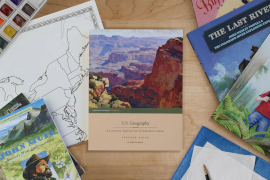 This course was created by Rebecca Manor but also has contributions from Audria Story. This study is divided into six sections. The first section covers the purpose and foundational elements of geography, and the following five sections delve into specific regions of the United States.
This course was created by Rebecca Manor but also has contributions from Audria Story. This study is divided into six sections. The first section covers the purpose and foundational elements of geography, and the following five sections delve into specific regions of the United States.
Resources required for the course are the United States Map by Beautiful Feet Books, National Geographic Kids United States Atlas; Geography: An Illustrated A–Z Glossary by B.C. Lester Books; Mapping Penny’s World by Loreen Leedy; The New Americans: Colonial Times, 1620-1689 by Betsy and Giulio Maestro; The Trailblazing Life of Daniel Boone and How Early Americans Took to the Road: The French & Indian War, Trails, Turnpikes, and the Great Wilderness Road, Daring Escapes, and Much, Much More by Charyl Harness; Buffalo Bird Girl, A Hidatsa Story by S. D. Nelson; John Muir: America’s First Environmentalist by Kathryn Lasky; Redwoods by Jason Chin; Ten Mile Day and the Building of the Transcontinental Railroad by Mary Ann Fraser; The Last River: John Wesley Powell & the Colorado River Exploring Expedition by Stuart Waldman; Bad News for Outlaws: The Remarkable Life of Bass Reeves, Deputy U.S. Marshal by Vaunda Micheaux Nelson.
Many lessons include discussion and research prompts, such as those on page 43 for The Trailblazing Life of Daniel Boone that say, “Learn more about the Wilderness Road and its history at the following site” [URL provided], and “Discuss how the Wilderness Road changed life for the native inhabitants as well as for the American colonists.”
Just a few of the many website links to sites are about waterfalls, exploring an Oconaluftee Indian Village, indigenous people’s crafts, making salt-dough maps, flower pressing, starting a butterfly garden, and following a recipe for Maryland Crab Cakes.
Students are sometimes told to research topics by watching videos or investigating websites, but the guide does not require any written record of their findings. You might do these investigations together and discuss them, but some parents might ask students to write about what they have learned. Most specific writing assignments in the course have students record information gleaned from the resource books or record information on the map. However, students are directed to write a report about redwood trees (based on Redwoods) in Lesson 29, and Dig Deeper on page 67 has students investigate native American tribes that used to live in their state and write about them in their notebook.
This level also includes a special project for each of the sections two through six (found under Rabbit Trails) that require household and craft resources and will take some time. For example, the first Section Project is “Landforms.” Students learn about landforms and create a salt-dough map of a landform of their choice. The second project, “Earth-Sun Geometry,” has students learn about the topic and then calculate the angle of incidence several times at the same time of day.
Students have numerous opportunities to draw, paint, or otherwise illustrate in their notebooks and nature journals.
Some earth science is included throughout the course, and recommended videos sometimes include evolutionary content. The guide usually alerts parents when this occurs.
Summary
Using colorful information books, literature, and multisensory activities, both Beautiful Feet Books U.S. geography courses work well for teaching basic geography while introducing students to all the states. The resources used are different for both levels, so students can complete both courses over time.

